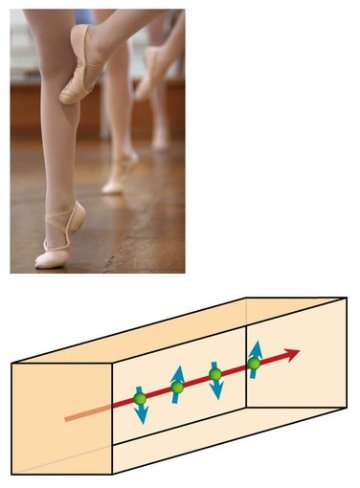Jun. 8, 2007 Research Highlight Physics / Astronomy
Choreography of electrons in one dimension
A novel theory successfully describes the different interactions governing electrons in narrow quantum wires
 Figure 1: Choreography of electrons. Like dancers in a ballet (left), electrons (green) moving along a quantum wire (right) assume carefully ordered arrangements with each other depending on parameters such as temperature, or the strength of the interaction between the electron spins (blue).
Figure 1: Choreography of electrons. Like dancers in a ballet (left), electrons (green) moving along a quantum wire (right) assume carefully ordered arrangements with each other depending on parameters such as temperature, or the strength of the interaction between the electron spins (blue).
A team of researchers from Argonne National Laboratory, US, RIKEN’s Discovery Research Institute, Wako, and the University of Minnesota, US, has presented a unifying theory that is able to describe the electronic states in a nanostructure known as a quantum conducting wire for a broad range of parameters.
There have been previous approaches to describe the quantum states of electrons in these wires, most notably the so-called Tomonaga–Luttinger theory. However, these theoretical descriptions are commonly limited to a narrow range of system parameters, namely very low temperatures and small energies.
The fabrication of nanostructures, including quantum wires that are small enough to confine electrons to a narrow channel, heralds a new physical regime. As a consequence of this confinement, the electrons cannot travel through such quantum wires in an arbitrary manner. Instead, they have to choreograph themselves into finely tuned arrangements in search of the state with the lowest energy. However, the actual state the electrons eventually assume depends strongly on parameters such as temperature and the strength of interaction between the electrons (Fig. 1).
“We have derived a general formula for the electronic states of quantum wires that extends the Tomonaga–Luttinger theory and at the same time greatly simplifies the calculation of the various properties of the system,” says RIKEN’s Akira Furusaki, a member of the research team. The team’s theory is published in Physical Review Letters 1.
The unified theory developed by Furusaki and colleagues initially separates the influence of the electric charge of the electrons from their spin—a fundamental quantum property of elementary particles that either can point ‘up’ or ‘down’. Once the individual contributions are combined, however, the new model is able to describe a broad range of different quantum states. For example, it correctly reproduces the Tomonaga–Luttinger theory, where electrons as well as spins show signs of long-range order. In addition, the researchers are also able to predict the properties of the state where the spins are completely disordered.
Importantly, the researchers predict an asymmetry in the energy distribution of the electrons. “No one expected to see such an asymmetry, and it will now be important to verify these predictions experimentally,” explains Furusaki. Although experiments on quantum wires have been performed before, they did not approach the extended parameter space made accessible by the new theory. Therefore, as experiments and additional theoretical studies venture into this new regime, further intriguing effects might be uncovered.
References
- 1. Matveev, K. A., Furusaki, A. & Glazman, L. I. Asymmetric zero-bias anomaly for strongly interacting electrons in one dimension. Physical Review Letters 98, 096403 (2007). doi: 10.1103/PhysRevLett.98.096403
